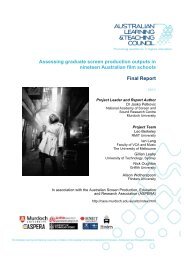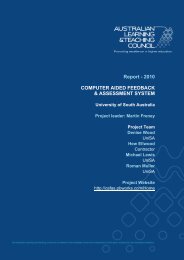Download Document - Office for Learning and Teaching
Download Document - Office for Learning and Teaching
Download Document - Office for Learning and Teaching
Create successful ePaper yourself
Turn your PDF publications into a flip-book with our unique Google optimized e-Paper software.
11 ReferencesAsmar C. (1999), Scholarship, experience, or both? A developer’s approach tocross-cultural teaching, International Journal <strong>for</strong> Academic Development, Vol. 4Issue 1, 18-27.Baumgart, N. <strong>and</strong> Halse, C. (1999), Approaches to learning across cultures: the roleof assessment, Assessment in Education 6(3), 321-339Biggs, J. B. (1996) Western misperceptions of the Confucian-heritage learningculture, in: D.A. Watkins & J.B. Biggs (Eds), The Chinese learner: Cultural,psychological <strong>and</strong> contextual influences, CERC <strong>and</strong> Australian Council <strong>for</strong>Educational Research, Hong Kong <strong>and</strong> MelbourneBriguglio, C. (2000), Language <strong>and</strong> cultural issues <strong>for</strong> English-as-a-second/<strong>for</strong>eignlanguage students in traditional educational settings, Higher Education in Europe25(3), 425-434Chalmers, D. <strong>and</strong> Volet, S. (1997), Common misconceptions about students fromSouth-East Asia studying in Australia. Higher Education Research <strong>and</strong>Development, 16(1), 87-98.Chen, H. (2003), Contextualizing citation behavior: Chinese graduate students’thesis writing, language <strong>and</strong> academic skills, Latrobe University.Chiu, Yi-Ching Jean. (2009), Facilitating Asian students' critical thinking in onlinediscussions, British Journal of Educational Technology 40, no. 1:Eisenchlas, S. <strong>and</strong> Trevaskes, S., (2003), <strong>Teaching</strong> intercultural communication inthe university setting: An Australian perspective, International Education 14(4), 397-408.Fussell S. R., <strong>and</strong> Zhang, Q. (2007), Culture <strong>and</strong> collaborative technologies. CHIExtended Abstracts 2007: 2845-2848Hofstede, G. (1986), Cultural differences in teaching <strong>and</strong> learning, InternationalJournal of Intercultural Relations, 10, 301-320.Hofstede G., (2001), Cultures consequences: Comparing values, behaviors,institutions, <strong>and</strong> organizations across nations. Sage Publications, Thous<strong>and</strong> Oaks,CA.Hong. P. Z (1991), A thorny journey: A study of the acculturation process of someChinese ELICOS students in Brisbane, Australia. Griffith University: Brisbane,Australia.Huang, H. <strong>and</strong> Trauth, E. M. (2007), Cultural influences <strong>and</strong> globally distributedin<strong>for</strong>mation systems development: Experiences from Chinese IT professionals. InProceedings of the 2007 ACM SIGMIS CPR Conference on Computer PersonnelResearch: the Global in<strong>for</strong>mation Technology Work<strong>for</strong>ce, April 19 - 21, 2007, St.Louis, Missouri, USA.Li, M. S, <strong>and</strong> Campbell J. (2008), Asian students' perceptions of group work <strong>and</strong>group assignments in a New Zeal<strong>and</strong> tertiary institution. Intercultural Education 19,no. 3: 203-216.154
















